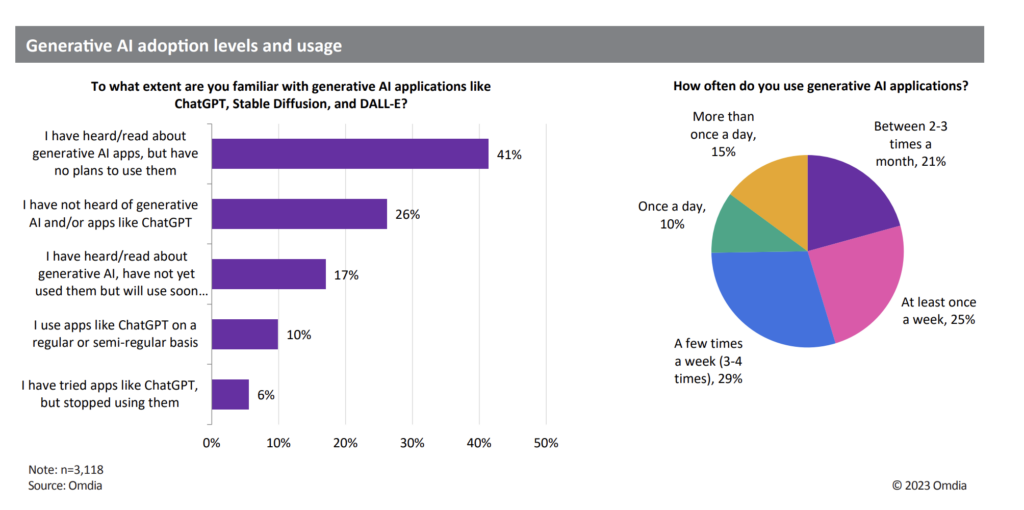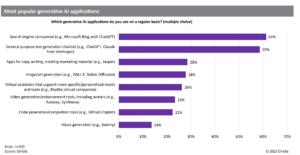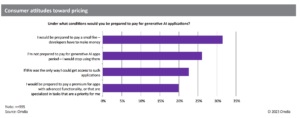
After more than 40 years of operation, DTVE is closing its doors and our website will no longer be updated daily. Thank you for all of your support.
DTVE Data Weekly: The rise of Generative AI
 Generative AI is backed by some of the most powerful tech companies in the world (e.g., Google, Amazon, Meta, Apple, and Microsoft) and has seen the rise of innovative, agenda-setting startups like OpenAI. The foundation models for generative AI are growing, with rapidly advancing capabilities. Models like GPT-4 can make associations, connections, and predictions in more sophisticated ways and produce outputs that appear increasingly authentic and convincing.
Generative AI is backed by some of the most powerful tech companies in the world (e.g., Google, Amazon, Meta, Apple, and Microsoft) and has seen the rise of innovative, agenda-setting startups like OpenAI. The foundation models for generative AI are growing, with rapidly advancing capabilities. Models like GPT-4 can make associations, connections, and predictions in more sophisticated ways and produce outputs that appear increasingly authentic and convincing.
Moreover, foundation models can be fine-tuned to support more specialist models and downstream tools. The prompt-style user interface for generative AI puts the tech in everyone’s hands, while many first-generation horizontal applications like ChatGPT are free to use. Taken together, this makes generative AI a flexible, innovative technology that can enhance applications across multiple use cases and drive personalization at scale.
However, generative AI faces challenges on many fronts. It can be used for manipulation and misinformation, negatively affect jobs, undermine data privacy, infringe on copyrights, and produce outputs that contain mistakes or are biased. The bottom line is that generative AI is a highly disruptive technology for good and bad, but the hype and noise surrounding it make it hard to get a balanced perspective. This is where listening to the consumer voice helps, providing a much-needed reality check on generative AI.
Omdia’s 2023 consumer AI survey of over 3,000 respondents in China, the US, and the UK explores what consumers value most about generative AI, their concerns, the applications they use most, views on pricing, and much more. The findings offer fascinating insights that will help stakeholders better understand generative AI in the consumer domain, allowing them to take advantage of the opportunities the technology offers and address the issues it presents.
Usage
The uptake of generative AI in the survey sample is modest, at 10% in total. But a further 17% of respondents say they have immediate plans to adopt (in a matter of weeks), which should theoretically see the survey sample user base increase to 27% in a short period. Another encouraging finding is that usage levels among those who have adopted generative AI applications are high. A quarter of respondents use generative AI applications once a day (10%) or more (15%), while another 29% use such apps a couple of times per week. Even more promising is that existing generative AI users anticipate their consumption will increase over the next 12 months, with 46% expecting their usage levels to increase while 37% predict a significant increase. But rising usage has implications regarding infrastructure, storage, and scalability, and service providers need to have the appropriate resources in place.
The low adoption of generative AI reflected in the survey may seem surprising given the significant supply-side push behind it, increasing the flow of services/products, and the extensive media coverage that draws attention to the technology. But noise and a supply-side push do not automatically equate to consumer adoption.
Moreover, not all the buzz around generative AI is positive, as noted. This will give consumers reason to think twice before adopting generative AI applications and, at worst, put them off altogether. This could be the case for the 41% of respondents in the survey who have heard of generative AI applications but have no plans to use them. The survey shows that consumers are mindful of the negative aspects of generative AI. Respondents are notably worried about the potential of generative AI to disrupt jobs (52%), how it could be used to commit fraud (50%), manipulate people and spread misinformation (48%), and the negative impacts on data privacy (44%). These and other concerns are consistent across regions. Consumers resistant to generative AI need attention and to be shown that applications have value, can offer benefits, and can be trusted.
Although the survey shows only a small number of initial users abandon generative AI applications (6% in total), it is important to identify and understand their reasons for doing so. These insights allow developers and service providers to address pain points and design better products, which should in turn lower abandon rates. The main reason that consumers in the survey stopped using generative AI was because they did not find applications useful or entertaining (43%). This is worrying as utility and entertainment are core horizontal drivers for consumer services. Almost as many respondents (42%) abandoned generative AI applications because the results produced were deemed poor quality. This is a fundamental flaw: services should, at the very least, be of a quality and standard that is fit for purpose. The objective should be generative AI applications that delight rather than disappoint.
Applications
The most widely used generative AI applications are search-enhanced by generative AI integrations and general-purpose text generation chatbots such as ChatGPT. Usage of both generative AI application categories is almost the same at 61% and 59%, respectively. We believe these findings are logical, given that generative AI text chatbots can support multiple use cases and are very flexible. Text generation apps like ChatGPT are also a more wellestablished category than generative AI apps for video creation or coding. The popularity of generative AI chatbots integrated with search engines also makes sense, as the two functions are complementary. Incorporating generative AI into popular apps like search also helps drive generative AI adoption and scale.
Outside of the above app categories, usage is lower. This could be because most other generative AI application categories have more specialized use cases (e.g., generative apps for AI coding apps, copywriting) that attract a narrower audience than horizontal apps. Even image generation apps are arguably less broadspectrum than general-purpose chatbots.
Pricing
The survey findings suggest that generative AI is not yet seen as so indispensable that fees for enabled applications are a given, and the message from the survey is that most consumers begrudge such fees. This is perhaps unsurprising given that many firstgeneration horizontal generative AI applications have been free to use, with fees only imposed for the more advanced iterations or for specialist/industry vertical apps. The bottom line is that fee structures for generative in the consumer domain are challenging and must be handled with care.
Only 31% of respondents are willing to pay a small fee for generative AI apps, while 26% would stop using them altogether if fees were imposed (26%). Less than a quarter of consumers in the survey (23% in total) would pay for generative AI apps if this were the only way to gain access, which is a negative motivation and one that could cause resentment among consumers. However, 20% of respondents are willing to pay a premium for advanced generative AI applications. This may seem low, but in the consumer domain (as opposed to enterprise scenarios), this is a promising indicator for premium applications.
Eden Zoller is Omdia’s chief analyst, Digital Consumer Platforms and AI.

